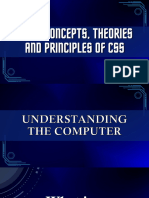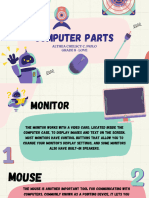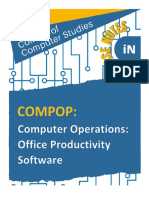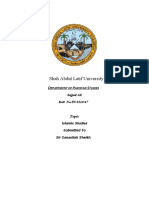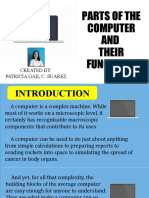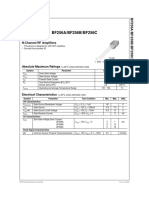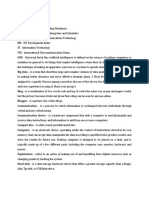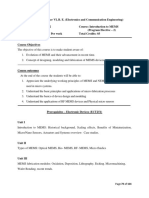INTRODUCTION TO
COMPUTER HARDWARE
�COMPUTER HARDWARE
•Hardware refers to the physical
components of a computer
system — things you can touch,
see, and hold.
�� CATEGORIES OF
HARDWARE
External (Peripheral) Hardware
Found outside the system unit. These
include devices like the mouse, keyboard,
monitor, and printer. They help users
interact with the system.
� CATEGORIES OF
HARDWARE
Internal Hardware
Found inside the system unit or CPU tower.
These components handle data processing,
storage, and system operations. Examples are
the motherboard, CPU, RAM, and hard
drives.
� THE 5 MAIN
EXTERNAL
HARDWARE PARTS
1. Monitor
2. Keyboard
3. Mouse
4. System Unit
(Tower)
5. Automatic Voltage
Regulator (AVR)
� MONITOR
The monitor is an output device that displays text,
images, and videos generated by the computer. It
connects to the graphics card or the motherboard,
showing the user everything the system is
processing.
Monitors come in different types:
• CRT (Cathode Ray Tube): Bulky and heavy,
older technology.
• LCD/LED (Liquid Crystal Display / Light
Emitting Diode): Slim, lightweight, and offers
better clarity.
�� KEYBOARD
The keyboard is an input device that allows users to type
text, enter commands, and control computer functions. The
most common layout is QWERTY, named after the first six
letters on the top row. It consists of:
• Alphanumeric keys: Letters and numbers.
• Function keys: Special shortcuts (F1–F12).
• Navigation keys: Arrows, Home, End, Page Up, Page
Down.
• Control keys: Ctrl, Alt, Shift, etc.
Special keyboards like ergonomic designs offer comfort for
long typing sessions, while gaming keyboards include
backlighting and programmable keys for faster gameplay.
�� MOUSE
A mouse is an input device that moves the cursor or
pointer on the screen, allowing you to click, drag, and
interact with programs. Types of mouse include:
• Wired: Connected by USB cable.
• Wireless: Uses Bluetooth or USB receiver.
• Optical: Uses LED light for movement detection.
• Laser: More precise tracking for professional or
gaming use.
Standard mouse have two buttons (left and right)
and a scroll wheel, while advanced models include
extra buttons for shortcuts and productivity.
�� SYSTEM UNIT
(CPU TOWER)
The system unit is the main body of the computer
that houses important internal components:
• Motherboard – Main circuit board.
• CPU – Processes all tasks.
• RAM – Temporary memory.
• Storage drives – Permanent file storage.
Many people mistakenly call the system unit the
CPU, but the CPU is only one part inside it. The
system unit is essential for processing commands,
managing data, and running applications.
� AUTOMATIC VOLTAGE
REGULATOR (AVR)
The AVR is an external device that protects
the computer from unstable electricity. It
regulates incoming voltage, ensuring a steady
power supply to the computer. This is
important because sudden power surges,
fluctuations, or brownouts can damage
sensitive hardware. In places with frequent
power issues, using an AVR or a UPS
(Uninterruptible Power Supply) is highly
recommended to prevent costly damage.
��THE 5 MAIN INTERNAL HARDWARE PARTS
� MOTHERBOARD
The motherboard is the central circuit
board that connects all components of the
computer. It distributes power and allows
communication between the CPU, RAM,
storage drives, and peripherals. It
contains slots for memory, ports for USB
devices, and sockets for processors.
Without a functioning motherboard, none
of the computer’s parts can work together.
� CENTRAL PROCESSING
UNIT (CPU)
The CPU is called the “brain of the
computer” because it processes all
instructions from software and hardware. It
performs calculations, makes decisions, and
executes commands in three steps: Fetch →
Decode → Execute. CPU speed is measured
in GHz (gigahertz)—the higher the speed,
the faster it can perform tasks. Modern CPUs
often have multiple cores, allowing them to
handle several processes at once.
�GRAPHICS PROCESSING
UNIT (GPU)
The GPU is responsible for rendering
images, videos, and animations. While
some CPUs have an integrated GPU,
powerful systems use dedicated GPUs for
better performance. A good GPU is essential
for gaming, 3D modeling, video editing, and
even scientific research like AI and machine
learning. GPUs have their own processors
and memory, allowing them to handle
complex visual tasks faster than a CPU
alone.
� RAM (RANDOM ACCESS
MEMORY)
RAM is the temporary working
memory of the computer. It stores
data and instructions currently in use
so the CPU can access them quickly.
Unlike storage drives, RAM is
volatile, meaning its contents are
erased when the computer is turned
off. More RAM allows for smoother
multitasking and faster program
performance.
� STORAGE DEVICES
(HDD VS SSD)
Computers store data in two main types of drives:
• HDD (Hard Disk Drive): Uses spinning
magnetic disks to store data. Offers large
capacity at a lower cost but is slower.
• SSD (Solid State Drive): Uses flash memory,
has no moving parts, and is faster, quieter, and
more durable, but more expensive.
Storage is measured in GB (gigabytes) or TB
(terabytes). SSDs are ideal for speed, while HDDs
are great for storing large files at a lower cost.
��OTHER INTERNAL COMPONENTS
• Power Supply Unit (PSU) – Converts electricity
from the outlet into usable power for the computer.
• Cooling Fans & Heat Sink – Prevent overheating
by dispersing heat from components like the CPU.
• Expansion Cards – Add extra functionality like
sound cards, Wi-Fi cards, or additional ports. All these
work together to keep the system functional and
efficient.
� INPUT DEVICES SUMMARY
Input devices send data into the computer. They
include:
• Keyboard – Text and command input.
• Mouse – Pointer movement and selection.
• Scanner – Converts physical documents into
digital files.
• Microphone – Captures audio.
• Webcam – Captures video.
� OUTPUT DEVICES SUMMARY
Output devices provide the results of processed
data. They include:
• Monitor – Displays visual output.
• Printer – Produces hard copies of documents.
• Speakers – Outputs audio.
• Projector – Projects display to a large screen.
� PROCESSING DEVICES
These devices are responsible for calculating,
managing, and executing instructions:
• CPU – Performs calculations.
• GPU – Handles graphics.
• RAM – Temporarily stores data in use.
• Motherboard – Connects all parts together.
� SUMMARY: HOW HARDWARE WORKS
TOGETHER
• Input: User types or clicks using keyboard and mouse.
• Process: CPU, RAM, and motherboard interpret and
act on commands.
• Output: Monitor or speakers show results.
• Storage: HDD/SSD saves files.
• Protection: AVR and cooling systems prevent
damage.
This teamwork makes computing possible.
�ACTIVITY 1
Read each question thoroughly and write your answer in 3–5
complete sentences.
1. Explain why an Automatic Voltage Regulator (AVR) is
important for a computer system.
2. Describe the role of the motherboard in connecting different
parts of the computer.
3. Discuss the difference between input and output devices, and
give one example for each.
4. Explain what happens to the data stored in RAM when you
turn off the computer.
5. Describe the importance of cooling systems like fans and heat
sinks in a computer.


